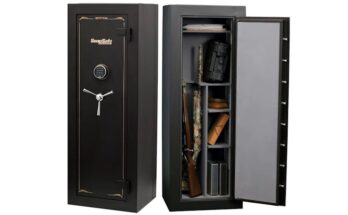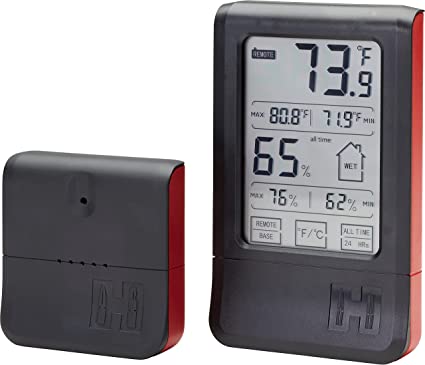Yes, a gun safe can get wet. However, exposure to moisture can lead to rust and damage.
Protecting your firearms and valuables from potential threats like theft, fire, and environmental damage is crucial, and a gun safe serves as the primary defense. While gun safes are often robust and designed to withstand various conditions, they are not completely impervious to water.
Whether due to flooding, leaks, or high humidity, moisture can penetrate a safe and cause corrosion or mildew, potentially harming the items inside. Hence, it is important to consider the location of your safe, as well as potential risks like water damage, when determining the best way to protect your investments. Choosing a gun safe with waterproof features or adding sealants and dehumidifiers can be an effective strategy to prevent moisture-related issues.

Credit: www.radonseal.com
Impact Of Moisture On Gun Safes
The security of firearms relies heavily on the condition of gun safes. Moisture poses a significant threat to these secure storage options. Understanding the impact of moisture leads to better protection for both the gun safe and its contents.
Rust And Corrosion: Long-term Risks
Rust and corrosion are silent adversaries for gun safes. These processes start subtle but can cause irreversible damage. Here’s how moisture becomes a catalyst for such risks:
- Metal degradation: Over time, exposed surfaces deteriorate.
- Compromised structure: A weakened safe no longer guarantees optimal security.
- Difficult operation: Rusty components make opening or closing the safe harder.
Regularly inspect your safe for signs of moisture. Apply preventative measures like dessicants or dehumidifiers to protect against these long-term risks.
Internal Humidity: Effects On Firearms And Ammunition
Inside a gun safe, the role of internal humidity is crucial. This is why:
- Damp conditions: Encourage micro-environments where moisture thrives.
- Firearm damage: Moisture accelerates wear, potentially causing malfunction.
- Ammunition quality: Deteriorates, effectiveness and safety may drop.
To maintain dry conditions:
- Use humidity control tools.
- Regularly check the safe’s interior.
- Keep a maintenance schedule.

Credit: www.homedepot.com
Water Exposure Scenarios
Think your gun safe is impenetrable? Water exposure might say otherwise. Understanding how moisture affects your safe is crucial. Here’s a breakdown of common wet scenarios your safe might face.
Floods: Understanding The Threat
Floods can wreak havoc on your property. Your gun safe is no exception. When a flood happens, your safe faces multiple threats:
- Water pressure can compromise safe seals.
- Extended submersion might lead to interior moisture buildup.
- Corrosion and rust risk increases with water exposure.
Proper safe installation and waterproofing measures can mitigate flood damage.
Accidents And Spills: Everyday Risks
Not just floods, even small water exposures matter. Let’s check the common accidents:
| Incident | Potential Damage |
|---|---|
| Spilled drinks | Moisture seeping into cracks |
| Broken pipes | Unexpected water surge |
| Leaking ceiling | Continuous water drip |
Ensure your safe location is clear of common water hazards. Regular checks can prevent accidental damage.
Features Of Waterproof Gun Safes
Protecting firearms means keeping them dry and secure. A waterproof gun safe does exactly that. It guards against water damage. This is vital in areas at risk of flooding or with high humidity. Such safes offer unique features. They’re designed to withstand environmental challenges. Here, we explore key aspects of waterproof gun safes.
Sealants And Linings: Keeping Moisture Out
High-quality sealants and linings are critical for moisture control. They provide a barrier against water. The safes have sealants around door edges. These block any water trying to seep in. Expertly fashioned linings inside the safe absorb any moisture that might enter. This keeps your firearms dry. Special attention is given to these features during design and production. This ensures complete waterproof protection.
Materials And Construction: Durability Against Water
Waterproof gun safes are built from robust materials. These include stainless steel or composite elements. These materials resist rust and corrosion. The construction process also focuses on preventing water entry. Tight seams and reinforced corners are common. These prevent weak spots where water might penetrate. Welded joints add extra protection. The result is a safe that can withstand water exposure.
Diy Waterproofing Techniques
Protecting your gun safe from water damage is crucial for the safety and longevity of its contents. Whether it’s from humidity, floods, or spills, moisture can be a gun safe’s worst enemy. DIY waterproofing techniques are cost-effective and easy to implement. They can greatly reduce the risk of water damage. Ready to safeguard your valuables? Let’s explore some simple yet effective methods.
Silica Gel Packs: Simple Moisture Absorbers
Silica gel packs are a straightforward solution to keep your gun safe dry. These small sachets contain silica beads. These beads absorb moisture. They are widely available and inexpensive.
- Place multiple packets inside your gun safe.
- Ensure even distribution for optimal protection.
- Replace or reactivate them regularly, as per the manufacturer’s instructions.
Commercial Dehumidifiers: Active Solutions
For a more active approach, commercial dehumidifiers offer constant protection. These devices work to reduce humidity levels inside your gun safe.
| Type | Function | Maintenance |
|---|---|---|
| Electric Dehumidifiers | Use heat to evaporate moisture. | Regular checks for functionality. |
| Desiccant Dehumidifiers | Absorb moisture through desiccant materials. | Desiccant refills are necessary. |
| Wireless Dehumidifiers | Reusable, wire-free moisture absorbers. | Recharging period needed. |
Remember, whichever method you choose, regular maintenance is key to ensuring effective moisture control.
Maintaining A Dry Environment
Keeping your gun safe dry is essential. It protects your firearms from rust and damage. Moisture can seep in secretly. Act now to prevent it—and save your valuables.
Placement And Positioning: Strategic Considerations
Choosing the right spot for your safe keeps it dry. Avoid basements and garages if you can. These areas often invite moisture.
- Elevate the safe from the floor.
- Place it on rubber or plastic feet.
- Avoid direct contact with walls.
- Airflow around the safe is a must.
Regular Checks: Preventing Water Damage
Frequent inspections keep your safe dry. Look for signs of moisture every month. Notice any changes in humidity inside the safe.
- Check for wet spots or rust.
- Inspect seals and door integrity.
- Use moisture absorbers like silica gel.
- Consider a dehumidifier for extra safety.
- React quickly to any signs of water.

Credit: www.amazon.com
Insurance And Protection Plans
Insurance and Protection Plans play a critical role in safeguarding your investment in a gun safe. Gun safes are built to protect against theft and fire, but water damage can be a real threat, particularly in the event of a flood or other disasters. Understanding insurance coverage and protection plans is essential to ensure you’re fully protected.
Coverage For Water Damage: What To Look For
When exploring insurance options for your gun safe, ensure the policy includes water damage coverage. Key aspects to consider:
- Type of water damage covered
- Limits on coverage amounts
- Deductibles and premiums
- Exclusions or limitations
Carefully review the policy details. Check if the coverage extends to the contents of the safe. Choose a plan that offers comprehensive protection.
Claims Process: Steps To Take After Water Exposure
After water exposure to your gun safe, act promptly to file a claim. Follow these steps:
- Immediately report the incident to the insurance provider.
- Document the damage with photos and descriptions.
- Preserve damaged items for assessment.
- Complete all required claim forms thoroughly.
- Stay in contact with the insurance adjuster.
Adhering to these steps helps ensure a smooth claims process. Receive compensation for repairs or replacement promptly.
Frequently Asked Questions Of Can A Gun Safe Get Wet?
Can Gun Safes Withstand Water Exposure?
Gun safes are designed with varying degrees of water resistance, but not all are fully waterproof. Many can withstand some exposure to moisture without damage to the interior or contents. It’s important to check the manufacturer’s specifications for details on water resistance levels.
How Does Water Affect Gun Safe Electronics?
Water can cause significant damage to electronic locks and components in a gun safe. This could result in lock failure or potential corrosion. To prevent this, some safes are equipped with water-resistant features, but electronics generally require additional protection from moisture.
What To Do If Your Gun Safe Gets Wet?
If your gun safe gets wet, immediately dry it off with towels and open it to air out the interior. Use fans or dehumidifiers to speed up the drying process. Remove all contents for individual drying and check for any signs of corrosion or damage.
Will Moisture In A Gun Safe Cause Rust?
Yes, excess moisture in a gun safe can lead to rust, especially on metal parts like guns and ammunition. Using desiccants or dehumidifiers inside the safe can help maintain a dry environment and prevent rust from developing.
Conclusion
Guarding against moisture is vital for gun safe integrity and content preservation. Regular inspections and proper maintenance are your safe’s best defense. Ensure your investments and safety measures remain uncompromised. Remember, a dry gun safe is a secure one. Protect, check, and maintain with confidence.



